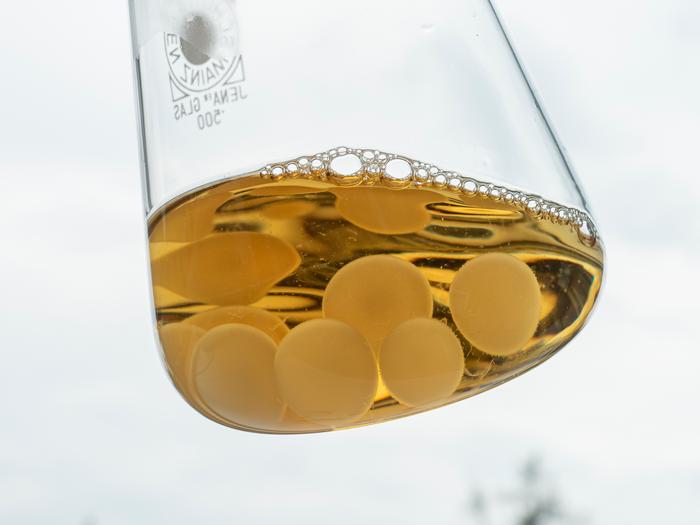Fungi have recently captured the attention of researchers due to their remarkable diversity and utility across various scientific fields. These organisms, which are more closely related to animals than plants, exhibit a plethora of forms and functions, making them a treasure trove for innovation. As the scientific community continues to explore the potential applications of fungi, one striking advancement has emerged from Empa’s Cellulose and Wood Materials laboratory: the creation of a functioning fungal battery. This innovative technology promises not only to harness energy from living fungi but also to challenge our conventional understanding of batteries themselves, particularly regarding sustainability.
The research project, supported by the Gebert Rüf Stiftung under its Microbials funding initiative, has resulted in a microbial fuel cell that utilizes fungi in lieu of the traditional bacteria typically employed in these systems. This novel approach involves a dual-fungus system, combining a yeast fungus and a white rot fungus in a synergistic partnership that leverages the unique metabolic pathways of each species. This development marks a significant leap forward in bioenergy research, providing a sustainable energy solution that is both non-toxic and biodegradable—a stark contrast to conventional batteries laden with harmful chemicals.
Understanding the mechanics of this fungal battery begins with a closer look at the two fungi used in the system. The yeast fungus is responsible for electron release through its metabolic processes, while the white rot fungus contributes a specific enzyme that facilitates electron capture and conduction. This intricate relationship allows the microbial fuel cell to generate enough electricity to power small devices, such as temperature sensors used in agricultural monitoring and environmental research. The ability of fungi to serve as renewable energy sources speaks volumes about their untapped potential in the realm of materials science.
Researchers faced numerous challenges during the development of the fungal battery. Finding suitable materials that not only allowed for healthy fungal growth but also maintained the mechanical and electrical properties required for battery functionality proved to be difficult. The ink had to meet various criteria: it required biocompatibility, ease of extrusion to ensure the preservation of live cells, and electrical conductivity. The challenges only intensified when they considered the lactose-laden diet preferred by the fungi, complicating the synthesis and application of the battery in real-world conditions.
The interdisciplinary nature of this project highlights the fusion of microbiology, electrical engineering, and materials science, propelling researchers like Carolina Reyes and Gustav Nyström into uncharted territory. The collaboration necessitated the acquisition of new skills, as microbiologists learned electrochemical characterization techniques tailored for bio-based 3D printing inks. This melding of disciplines signifies a growing recognition of the potential that lies at the intersection of life sciences and engineering.
The living nature of the materials involved in the fungal battery introduces another layer of complexity. Storing these batteries in a dried state and reactivating them with the addition of water and nutrients reflect an innovative approach to battery maintenance. The biological components can tolerate dry conditions, although this process requires careful management to ensure that the fungi remain robust and functional. This adaptability opens avenues for on-site applications where traditional power sources may be impractical.
Future work is poised to enhance the performance and longevity of these fungal batteries as researchers investigate additional fungal species that could provide even greater energy output. The potential for diversification within this microbial energy paradigm is vast. Each new species could introduce novel metabolic pathways, adding to the already promising landscape of renewable energy based on biological resources. This research represents only a fraction of the inherent possibilities awaiting exploration in the realm of materials science.
In conclusion, the development of a 3D printed cellulose-based fungal battery stands as a powerful testament to the innovative strides being made toward sustainable energy solutions. By embracing the complexity and diversity of fungi, researchers have begun to reveal the untapped potential of these organisms. As the scientific community continues to investigate their various applications, we can expect exciting revelations that could illuminate new pathways for renewable energy and environmentally friendly materials technology.
As the researchers at Empa forge ahead, they remain optimistic about the impact their work will have on both the scientific understanding and practical applications of fungi in energy production. Their commitment to sustainable practices coupled with technological innovation may well set the stage for a new chapter in green energy solutions, ultimately contributing to a more sustainable and eco-friendly future.
—
Subject of Research: Fungal batteries utilizing microbial fuel cells
Article Title: 3D Printed Cellulose-Based Fungal Battery
News Publication Date: 15-Oct-2024
Web References: http://dx.doi.org/10.1021/acssuschemeng.4c05494
References: Empa’s Cellulose and Wood Materials laboratory publications
Image Credits: Empa
Keywords: fungi, microbial fuel cell, renewable energy, cellulose, 3D printing, sustainability, biodegradable batteries, materials science, environmental research, electrical engineering.





